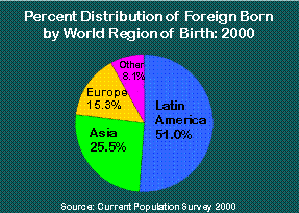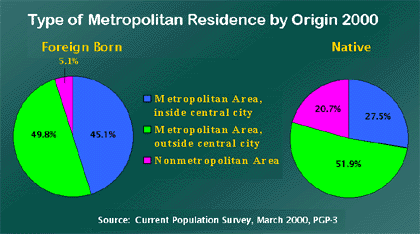
| Search our site or search the web: |
U.S. Immigration Facts
"Nearly 70,000 foreigners arrive in the United States every day. Most of these travelers are visitors, not settlers. More than 60,000 are tourists, business people, students, or foreign workers who are welcomed at airports and border crossings. About 2,200 daily arrivals are immigrants or refugees who have been invited to become permanent residents of the United States. Finally, about 5,000 foreigners make unauthorized entries each day. About 4,000 of them are apprehended just after they cross the U.S.-Mexico border. But nearly 1,000 elude detection, or slip from legal to illegal status by violating the terms of their visas. Many will remain, while others will return to their home countries."Immigration to the United States
Population Reference Bureau
Approximately 28.4 million foreign-born people live in the United States, representing 10.4 percent of the U.S. population.
 Recent shifts in patterns of immigration have resulted in a much more racially and ethnically diverse foreign-born population.
Recent shifts in patterns of immigration have resulted in a much more racially and ethnically diverse foreign-born population.
Prior to the mid-20th century, immigrants came primarily from northwestern Europe (Great Britain, Ireland, Germany, Scandinavia, France) and from Canada. By 1999, there had been a dramatic shift. Over half of the foreign-born population now originated from Latin America. Europe accounts for only 16 percent, and Canada for 3 percent. Only 2% of the foreign-born originated in Africa.
Relatively few (10%) of the foreign-born are under age 18 compared with 28.3 percent of the native population. The largest percentage of foreign born are in the 35-39 age group.
The foreign born are more geographically concentrated than the native-born population. Three-quarters of the foreign-born population is concentrated in just eight states (California, New York, Florida, Texas, New Jersey, Illinois, Massachusetts, and Arizona).

The foreign born are more likely than natives to live inside central cities of metropolitan areas.
The 1990 census tabulated almost 32 million speakers of hundreds of languages from other continents as well as more than 330,000 people speaking more than 130 native North American languages at home.
More than one in five legal immigrants settle in California, and the 355,600 immigrants who landed there and in New York in 1996 represented 39 percent of U.S. immigration. New York City alone was the planned destination of 15 percent of immigrants.
With such a large share of immigrants heading to just two states, it's no wonder that some states receive very few. Idaho, Kentucky, Nebraska, and South Carolina each claimed only 0.2 percent of immigrants in 1996. The 8,100 people who planned to go to these four states were fewer in number than those thinking of living in El Paso, Texas.
Mexico was the country of origin for the largest share, at 18 percent. The Philippines was next, at 6 percent, followed by India, Vietnam, and China, 5 percent each.
Immigration has a modest but positive effect on the U.S. economy, according to American Demographics, adding about $10 billion a year to America's economic output. Even more important is the contribution immigrants and their children make just by being here to provide workers and leaders for the future. If today's immigration totals hold steady, it will account for about two-thirds of U.S. population growth over the next 50 years.
Presbyterian Fronter Fellowship has published an interesting list of Ethnic Groups in the USA with over 100,000 population (1996).
The Population Reference Bureau publishes articles analyzing data and trends from the 2000 USA Census.
For more U.S. population statistics (including free demographics for your state), see "Who Lives in Your State?".
The U.S. Census Bureau offers maps, tables and articles at its American FactFinder site.
![]()
Back to Ethnic Harvest site map
* Back to Web or Site Search
Copyright © 1999-2011 Ethnic Harvest. All rights reserved.
